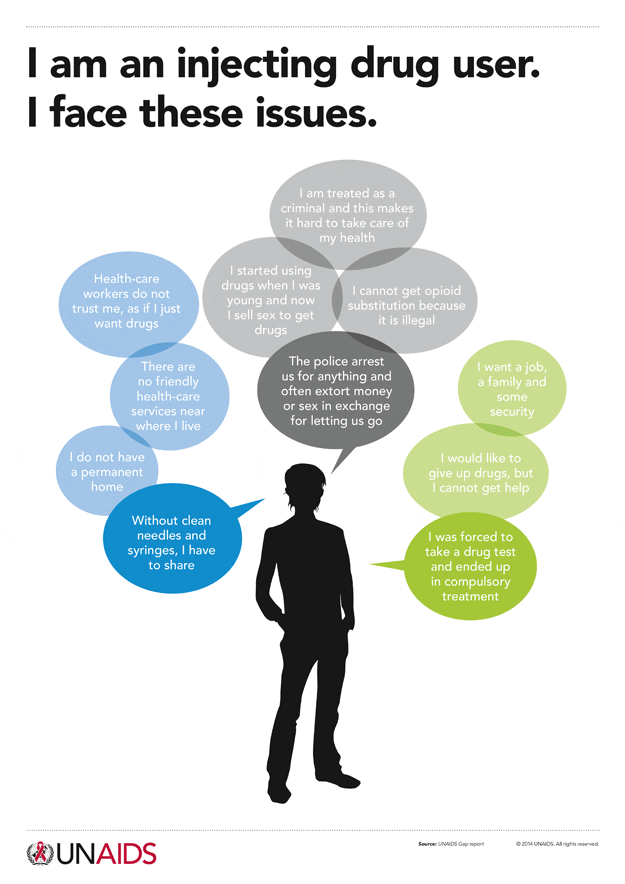UNAIDS slams Russia and calls for decriminalisation of drug use
The International AIDS Conference is always accompanied by high-profile report launches and announcements, and the 2014 event in Melbourne is no different. One of the highlights, however, has been “The Gap Report” – launched by the Joint UN Programme on HIV/AIDS to explore the gap between those accessing HIV treatment and services and those that are left behind.
The Gap Report includes the usual comprehensive datasets and headline figures that we have come to expect from UNAIDS: 35 million people are living with HIV, 19 million of whom don’t know it. It also describes the ‘Hopes’ (such as fewer new infections, reduced mother-to-child transmission, and fewer HIV-related deaths) and the ‘Gaps’ after three decades of the global HIV response (such as the lack of services for people who inject drugs, for whom HIV prevalence is estimated to be 28 times higher than in the general population). The report also highlights existing inequalities between populations and locations – focusing particularly on regional variances in the HIV epidemic, and on 12 most-at-risk groups.
The report calls out the Russian Federation in particular for their appalling record in terms of HIV and people who use drugs. Russia accounts for 2 percent of the global HIV prevalence, is home to two-thirds of all HIV cases in Eastern Europe and Central Asia, and has 80 percent of the region’s new HIV infections. It is also one of the few countries with a growing HIV epidemic, fuelled by the fact that 2.3% of the Russian adult population inject drugs. The report states:
“In the Russian Federation, where the official policy is against providing opioid substitution therapy services for people who inject drugs, the HIV prevalence among people who inject drugs is estimated to be between 18% and 31%. In contrast, in countries in Western and Central Europe, where coverage of services such as needle and syringe programmes and opioid substitution therapy is high, the numbers of people becoming newly infected with HIV are low”.
“The Russian Federation… continues to steadfastly deny the evidence on the effectiveness of harm reduction, and the rates of HIV infection among people who inject drugs in the country are among the highest in the world”.
Following on from the World Health Organisation’s recent calls for the decriminalisation of drug use to assist the HIV response, UNAIDS also makes a strong call for drug law reform in their report. The report cites “Criminalization and punitive laws” as the number one reason for the elevated risks faced by people who inject drugs, and its first recommendation to close the gap is to “Transform punitive laws that criminalize the use of drugs”.
The Gap Report also states that “The majority of national drug control policies focus on supply reduction and law enforcement against any drug use, and people who use drugs are often collateral victims of those interventions”, and that “The criminalization strategy adopted by national drug control systems hinders the HIV response, as fear of arrest impedes people’s access to and the uptake of HIV services”. At the same time, the report acknowledges that “Many governments find it politically unpalatable to provide adequate HIV and health services for people who inject drugs, who are a socially stigmatized and criminalized population”.
Crucially, UNAIDS explicitly state that “In order to close the programming gap for people who inject drugs”, countries must “Transform punitive laws that criminalize the use of drugs” and “End the criminalization of people who use drugs”. They emphasise that “Continued movement away from criminalization towards a humane and supportive approach to drug users and the problems they face will transform national strategies into the best public health outcomes”, and also call for the end of arbitrary detention, compulsory treatment, torture and other forms of ill-treatment.
The report also calls for the expansion of evidence-based and cost effective harm reduction services, addressing institutionalised stigma and discrimination, and increasing funding for harm reduction – and notes that “Despite the challenges they face… people who inject drugs continue to care for themselves, their families and each other. They overcome huge hurdles on a daily basis, often at an enormous cost. A concerted effort to remove the obstacles that prevent them from accessing the range of services they want in a way that they can use them is required.”
The accompanying press release states that the international community can end the AIDS epidemic by 2030 – averting 18 million new HIV infections and 11 million deaths. But, in the words of UNAIDS Executive Director Michel Sidibé, “There will be no ending AIDS without putting people first”.
Topics
Related Profiles
- International Drug Policy Consortium (IDPC)
